The Energica Ego+ RS and Eva Ribelle RS are proving that electric bikes are closing in
You may be a die-hard proponent of the internal combustion engine we love so much and shun the move to a more electrified motorcycling future, but answer honestly: if you were invited to ride what are claimed to be the most powerful electric bikes on the planet, with direct lineage to the MotoE World Cup machinery, would you have a crack? Of course you would!
I had the opportunity to do just that on the Gold Coast recently on Energica’s fully faired sports machine, the Ego+ RS, as well as its naked sibling, the Eva Ribelle RS. And both machines are bloody impressive.
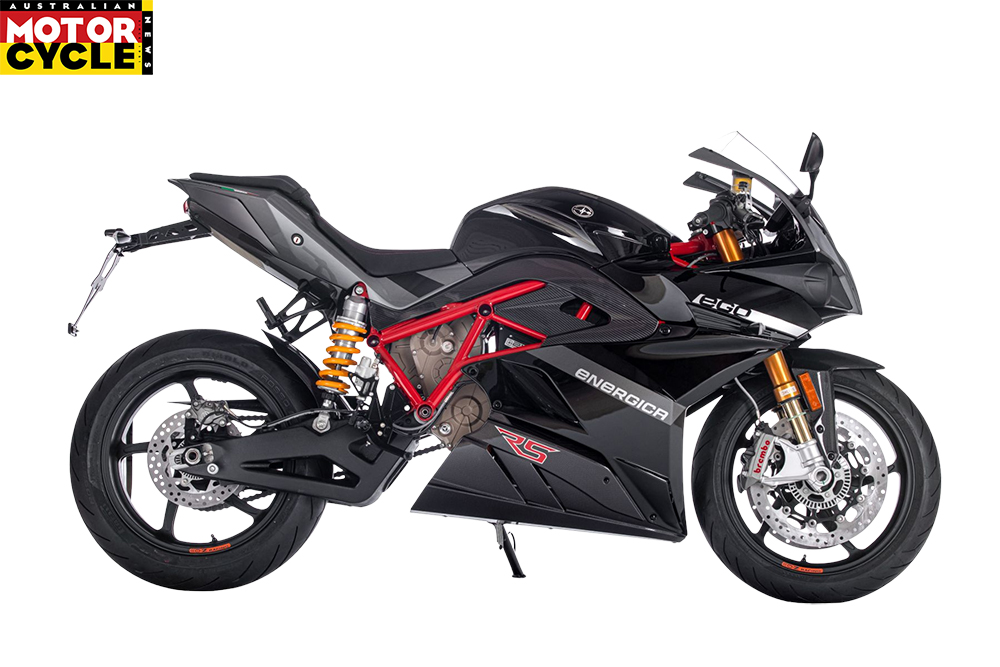
The Ego and Ribelle share most of their componentry, with the main difference being the obvious addition of a fairing on the Ego and the subsequent riding position that comes with it. In standard guise, both feature a tubular-steel trellis frame, a 43mm fully adjustable USD Marzocchi fork, a rebound- and preload-adjustable Bitubo rear shock, and both wear the same high-end Brembo braking package and same rubber.
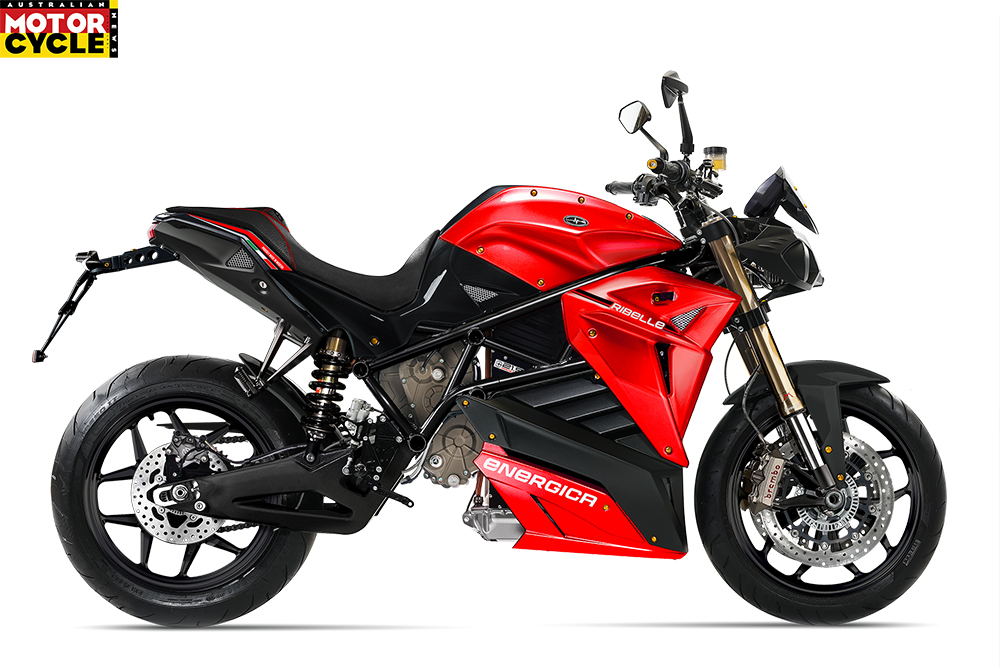
Both, also, are powered by the same liquid-cooled, Hybrid Synchronous 300-volt EMCE motor that puts power to the ground via a reduction gearbox and chain final drive. And powering the whole outfit is a 21.5kWh lithium polymer battery that’s used as a stressed member between the steel trellis frame.
To increase range there’s a four-level (Low, Medium, High and Off) regenerative braking system that feeds power back into the massive battery when the rider gets off the gas, so to speak.
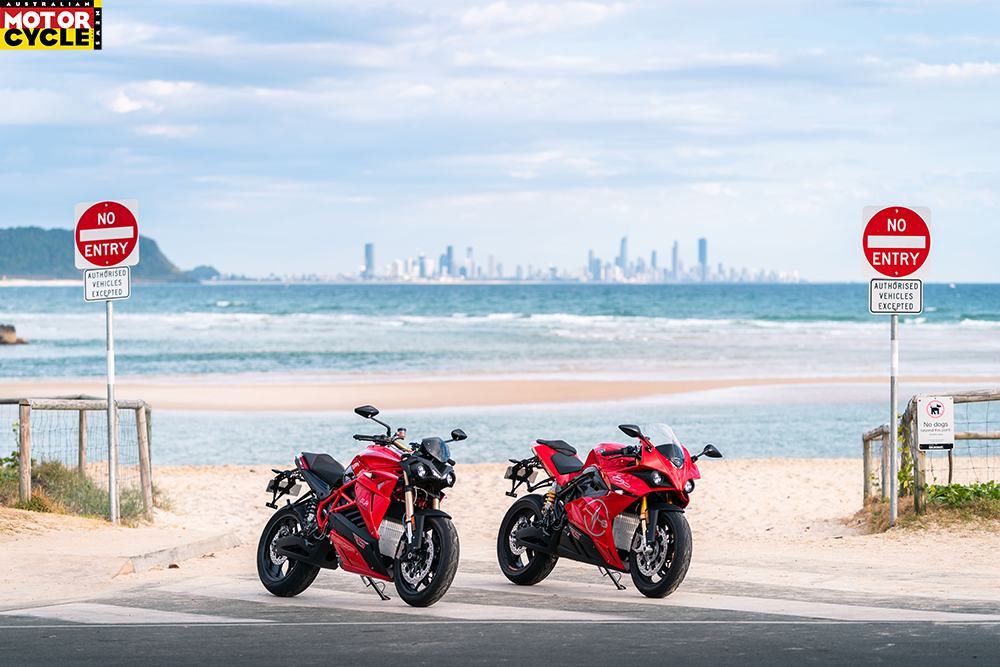
Charging the battery from a wall plug at home takes around eight hours, however a DC charger achieves full charge in around 45 minutes and an 80 percent charge in just 16 minutes. The charging plug is located underneath the seat, and the TFT dash displays the charging progress. On the Ribelle there’s also a fancy Energica symbol on the tank that lights up when it’s charging.
Are you bored yet? If you’re like me, what you really want to know is how it goes and how long will it go for before you have to charge up?
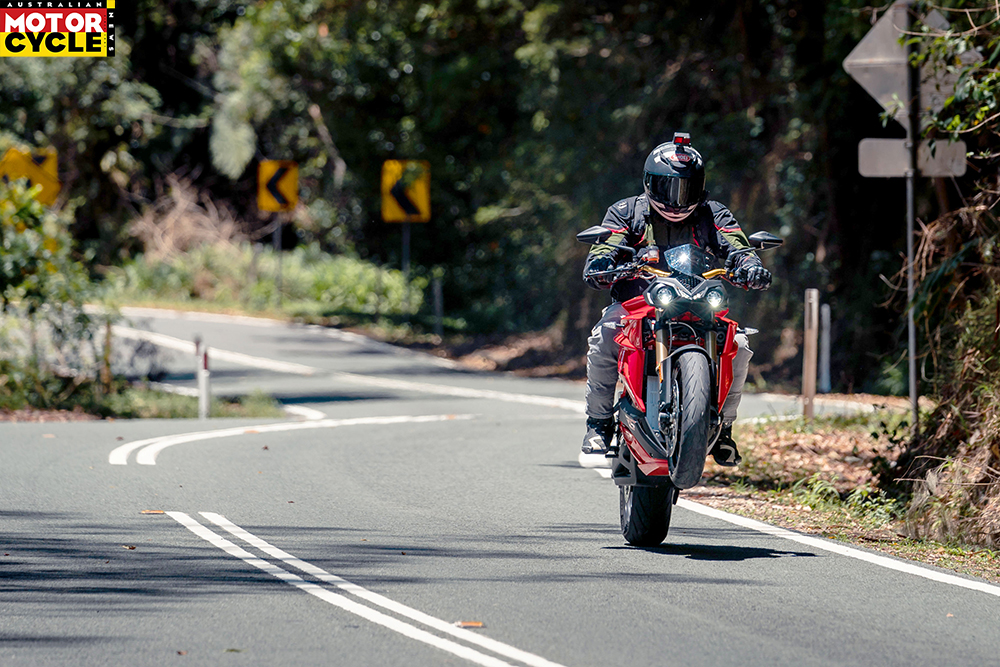
Well, both the Ego and Ribelle deliver an impressive 126kW (171hp) of claimed peak power and an arm-stretching 222Nm of torque (up in 2023 guise from 215Nm) from 1rpm, and Energica claims a 0-100km/h time of just 2.6 seconds.
For comparison, the Harley LiveWire that I rode (AMCN Vol 70 No 06) produced a claimed 78kW (106hp) of peak power and 116Nm of torque. And after riding these two missiles I wouldn’t be prepared to argue with Energica’s claim that the Ego RS and Ribelle Eva RS are the world’s most powerful electric motorcycles.

As for range, Energica claims a city range of 400km which, pre-ride, I reckoned was achievable in Eco mode with a tailwind and going down a hill on the back of a ute. The Modena-based company also claims a combined city/country range of 246km. Read on to find out how accurate these mileage claims are.
Both the Ego RS and Ribelle RS are available in ‘standard guise’ with the above-mentioned level of spec, but each bike is made to order via the company’s online configurator where you can change the spec to suit your preferences and budget. Your new bike will take about eight weeks to build, and is then loaded on a ship for the journey to its new owner.
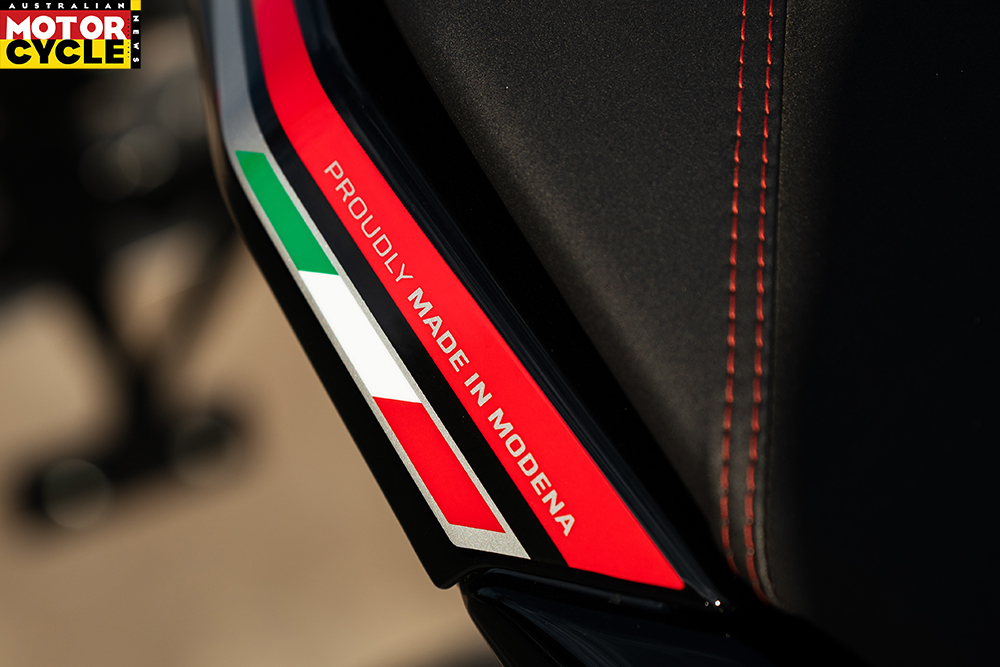
The Ribelle on test here was in standard trim, however the Ego had the optional Öhlins suspension and forged OZ Racing aluminium wheels. According to the Energica configurator, the Ego with that setup will set you back just under $65,000, plus on-road costs.
For the love of the sweet green Jesus, these things are fast! From a standing start they really do take your breath away with the way they accelerate so ferociously. There are six levels of traction control including off, with one being the least intrusive and five being the most. In the lowest setting, some slippage is allowed but the system mainly keeps the rear under control. With it turned off, if the grip levels are compromised in the slightest, both machines will break into wheelspin if pinned.
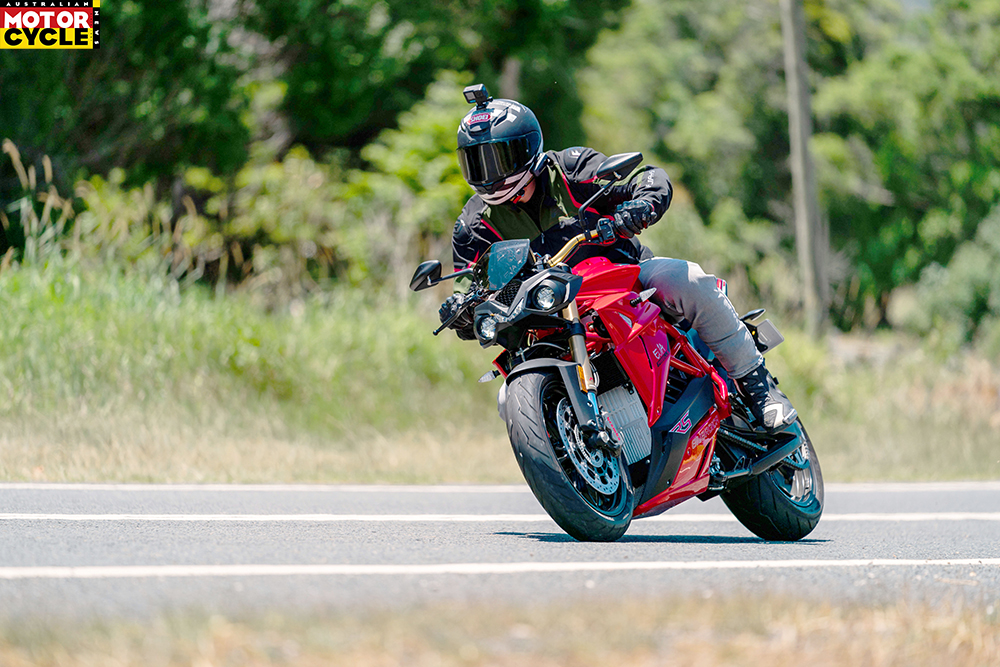
I wanted to practice my wheelies so I switched the traction control off – which also acts as wheelie control and will interrupt your fun if its on. And with 215Nm of torque right off a closed throttle you need to be on your game. If the surface isn’t that perfectly grippy new tarmac, then both bikes will attempt to wheelie and wheel spin simultaneously. And if the rear tyre does grip immaculately, the front comes up very quickly, so be sure to cover that Brembo rear brake. Keep in mind this is happening without the assistance of a clutch, and with no gear changes the wheelie could theoretically continue uninterrupted until the bikes run out of revs.
The traction control really comes into its own on exiting corners – 215Nm of torque is approaching Triumph Rocket 3 territory, but whereas the Rocket 3 uses a fat 240-section rear tyre to manage traction, the two Energicas are relying on a relatively skinny 180-section rear. Hitting your local twisties with traction control turned off is only for the highly skilled, brave or stupid, because the Diablo Corsa III fails to keep the rear under control while on the side of the tyre at anything approaching full throttle.

According to the Aussie importer, Australia Electric Motor Co., the Ribelle is restricted to 200km/h and the Ego+ RS is restricted to 240km/h. However, I can tell you the Ego is also restricted to 200km/h – don’t ask me how I know.
Those worried about being flattened by other motorists due to the quietness of electric bikes shouldn’t be too worried. The three gears doing their thing in the reduction box are quite loud so it’s not a super silent ride. I quite like the sound – it reminds me a bit of the cam gear noise in the old Honda VFR750, only louder.

Despite those decent range claims, once on the open road where regenerative braking is out of the equation, range is considerably reduced and both machines limped home with less than 10 percent battery remaining after a smidgeon over 150km. In fairness, the ride was on the high end of the enthusiastic scale and involved flowing country roads with very limited opportunity for the regen braking to do its thing.
I reckon this is pretty good and here’s why. Firstly, I’d be pushing poo up a hill with a twig to get much more range than that from my old VTR1000 Firestorm and secondly, have you ever tried riding a modern-day sportsbike more than 150km without running out of juice, catching on fire from excessive heat (hello V4 engines) or requiring a well-trained chiropractor?
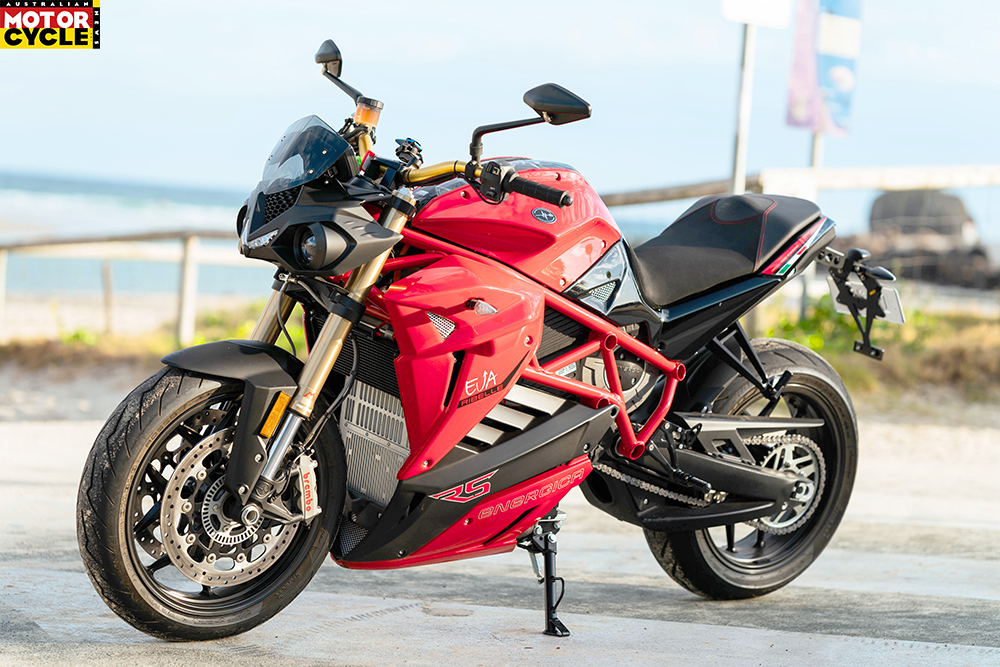
Like any sportsbike, the Ego is uncomfortable and puts maximum weight on the wrists, so I much preferred the upright riding position of the Ribelle. In fact, for the most part I preferred the handling of the Ribelle over the Ego, too, despite the trick suspension on the latter.
There’s no denying I’m a fan of the power and torque these two punch out; it’s exhilarating. And when I was riding around town I was praying that I’d get every red light at each intersection just so I could launch off the lights.
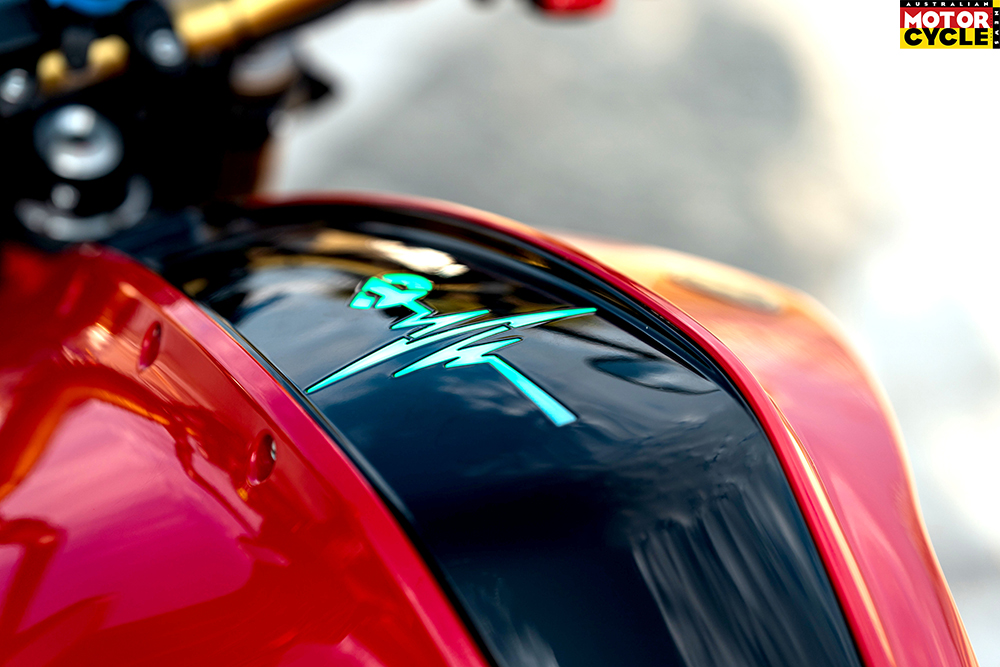
However, apart from the power and torque, I can’t really see the benefits of four years of MotoE development – although I’m sure there’s under-bonnet stuff that I don’t have the technical smarts to appreciate.
Are the Energicas powerful? Yes, they are impressive and addictive, but I wasn’t anywhere near as impressed with the handling. Both bikes weigh in at a claimed 260kg making them by far the heaviest sportsbike and hypernaked on the market. Weight has a lot to do with the cumbersome handling but, that said, at 260kg they are slightly lighter than the 264kg claimed wet weight of a Gen III Hayabusa and the ’Busa is a better handling motorcycle than either of these two. So the handling deficiencies must come down to more than just weight.

The front-end on the Ribelle feels pretty good but the rear Bitubo shock is out of its depth when the cornering pace is wound up, which limits the ability to push, especially on bumpy corners. I stiffened up the rebound to stop the Ribelle from pogoing through bumps, but there was very little discernible difference between settings and, in standard form, you won’t be tuning the trait out. This limiting factor meant I couldn’t push the front as hard as I could on the Ego.
The trick Öhlins front-end on the Ego provides better feedback about the front tyre’s intentions which heightened a trait that I grappled to come to terms with. Turn-in is on par with other bikes lugging this sort of weight – cumbersome. And while the rear-end is much better than the Ribelle, feedback from the front continually gave me the impression that the weight of the bike was going to push the tyre to the point of no return. I was pushing reasonably hard, but I never got comfortable with the front-end feel of the Ego.

Maybe it’s the relatively short swingarm due to the sheer size of the battery, perhaps it’s a case of how the weight of the battery is carried, or perhaps it’s something as simple as tyres.
Both machines are fitted with Pirelli Diablo Rosso III rubber. A decent tyre for sure, but Pirelli has upped its game with Rosso IV and most superbikes and hypernakeds are fitted with a Diablo Rosso Corsa rather than the less-sporty Rosso. A stickier, more modern tyre may make a difference to the handling, but I suspect it’s more a case of excessive weight bias over the front.
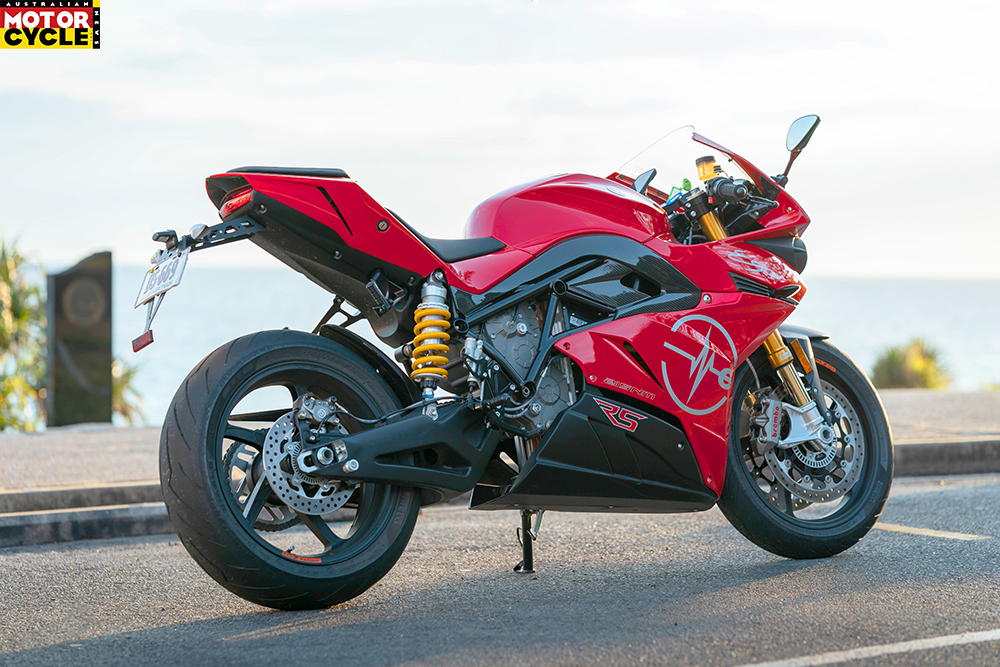
Straight out of the box, the LiveWire handles better than either the Ribelle or Ego, but I guess that’s irrelevant now that we can’t get the LiveWire in Australia anymore.
Brakes are certainly up to the task, even with the portly combined dimensions of the machinery and my chassis, but we’ve come to expect that from Brembo, haven’t we? Both run twin 330mm floating discs tugged at by four-piston monobloc calipers. The rears feature a 240mm disc with a twin-piston Brembo caliper.
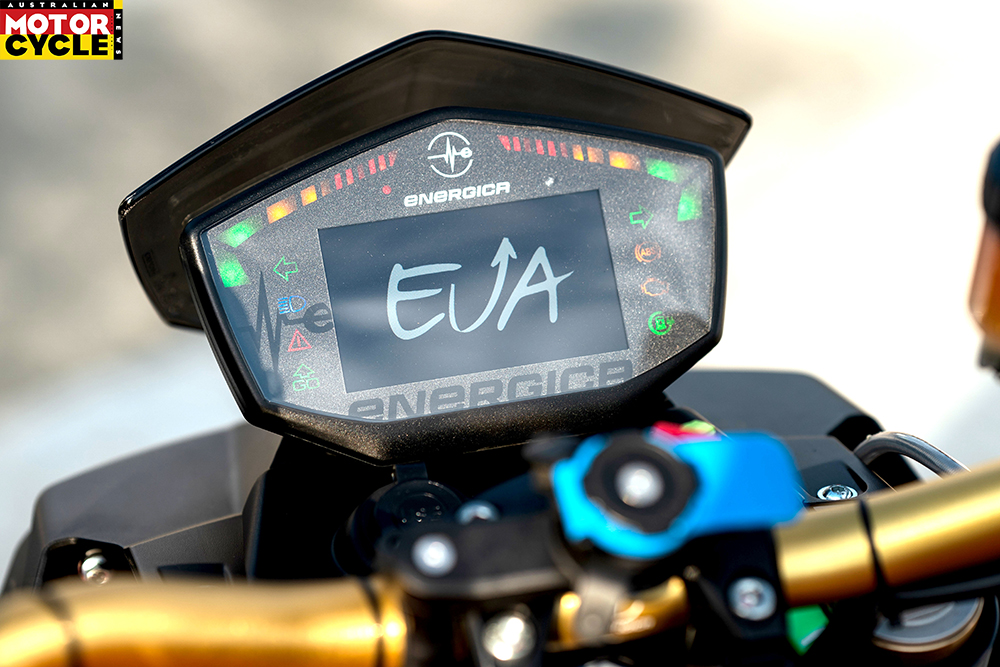
Both ends have excellent feel, bulk power and can have the Bosch ABS working overtime if you’re aggressive with either end. The Ego’s lever felt a bit spongy but I’d put that down to needing a good bleed than anything being wrong or inferior. After all, the brake packages are identical and the Ribelle’s brakes are awesome.
The traction control’s intervention is lovely and progressive for the most part. The only time it isn’t is on loose surfaces when it can cut power slightly more abruptly than systems on other bikes.

The controls are standard across both bikes with the majority of goings on happening via the left-hand switchblock. Operation of the settings and modes via the colour TFT screen is easy to use once you work out the process, which doesn’t take a diploma to learn. If a relatively small mob like Energica can make a user-centred interface that’s fairly straight forward and easy to use, why can’t some of the larger manufacturers?
The cruise control buttons are located on the right-hand ’bar, and I’ve heard some complaints that the main activation button can be a pain to use. With my 3XL sized hands I didn’t have an issue at all but I can see how the stretch to the button might be a pain to the little-handed.
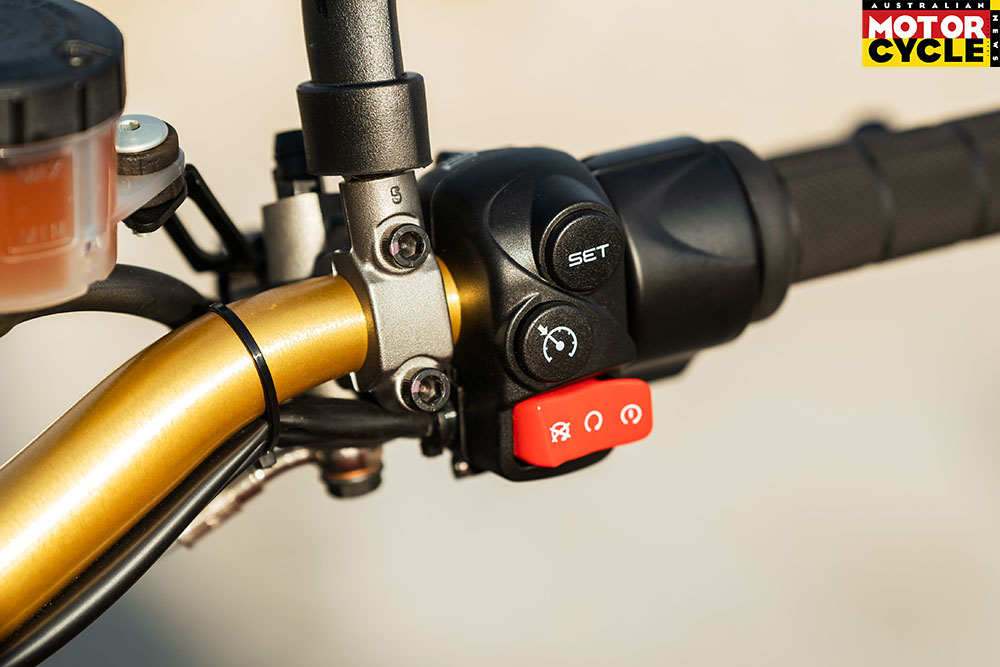
Finally, the looks and finish. These two are the first electric bikes that don’t look like they are designed by someone taking a punt at what bikes might look like in the future. They look like any other bike until you snoop around up close. What’s more, the paintwork is deep and lovely – they both look great. I had plenty of comments about how good both bikes looked, and many were surprised when informed they are electric bikes. Buy one of these and you’ll attract no shortage of admirers wherever you go.
So are either of these two ready to replace your Panigale, Super Duke or trackbike? Well, that depends on what you want from a motorcycle. If you’re wringing the neck of either of these two, you’re going to need to whack them on a charger after about 150km. I can hear the whinging now but my retort would be this: they charge to 80 percent in about 20 minutes and that will get you a similar amount of distance down the road again. So, yes indeed, you could realistically replace your road-going sportsbike with the Ego+ RS.

The Ribelle was by far my favourite of the two. It’s far more comfortable, it’s a hoot around town and felt a tad more reassuring when cornering.
The price of admission isn’t cheap though. The Ego+ RS in standard form will set you back $55,329 (plus on-road costs) and an Eva Ribelle RS will cost you $52,471 (plus on-roads). They aren’t cheap but the price should come down as the technology improves and they become more popular.

I know some people will say – and rightly so – that over time you claw back the extra dollars spent in savings on fuel, servicing and consumables, but if you’re spending $50k-plus on a motorcycle then you’re probably not the penny-pinching type.
Energica’s two bikes aren’t going to suit everyone and there are negatives – mainly weight and price – but after riding them I came away with a feeling that electric bikes are almost there.
A few more early adopters, a little more range and a bit less weight and electric bikes like these will give conventional combustion machinery a run for their money – and more than just from the traffic lights.
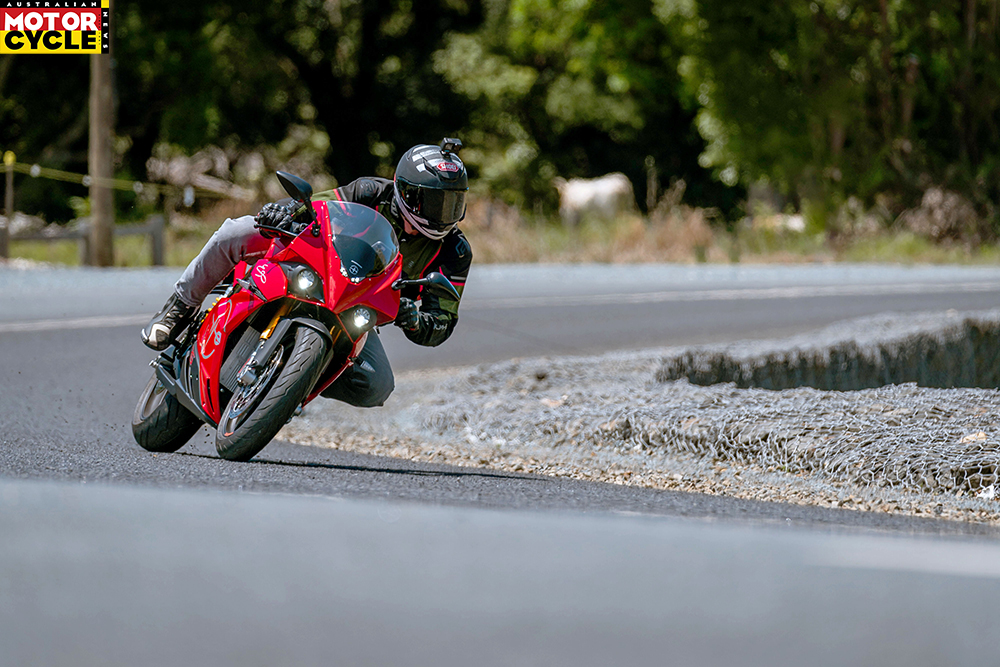
TEST: PETE VORST PHOTOGRAPHY JOE SHEPPARD